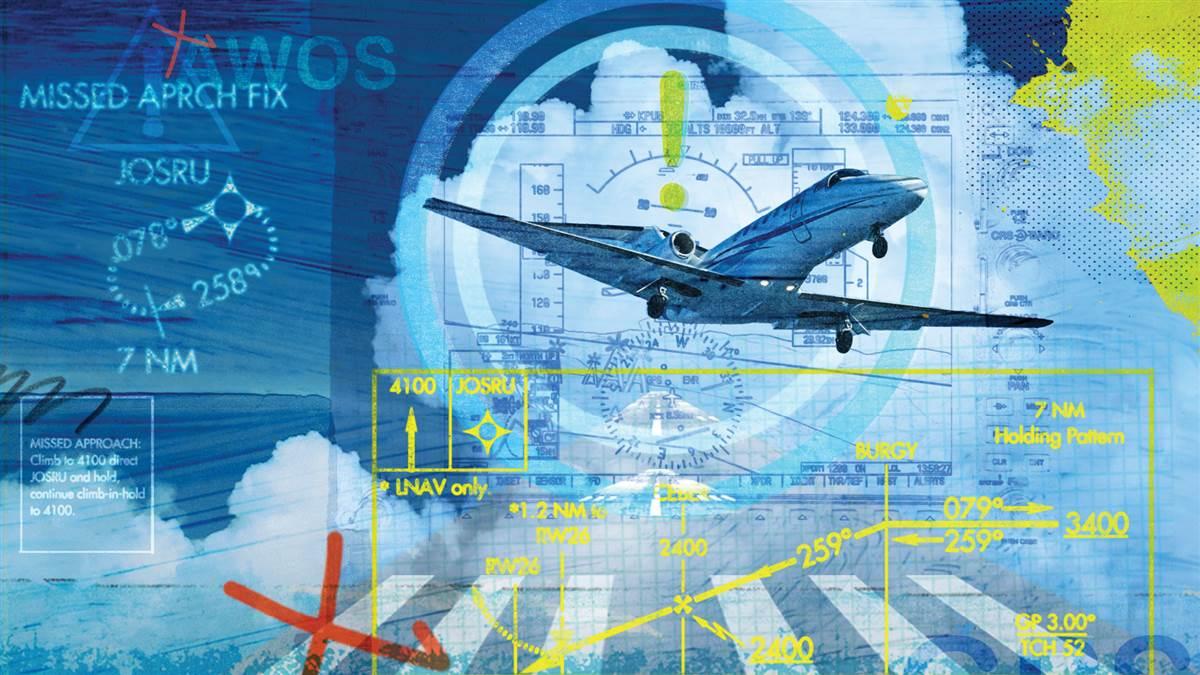Go-around surprise
Technology has made the IFR miss a thing of the past—almost
By J. Mac McClellan
I haven’t missed an IFR approach—except in annual simulator training—in many years. To put it mildly, I was more than a little surprised when the alert flashed, and the computer voice called minimums and all my co-pilot and I could see was the inside of a cloud.

I’m not bragging about my flying skills, just being reminded how several technological developments over the past 20 to 30 years have made the approach miss rare, and thus even more surprising and demanding for pilots.
The most obvious instrument approach technology advance has been GPS-based RNAV approaches, particularly the LPV (localizer performance with vertical guidance). I can’t think of an airport I’ve been to in years that doesn’t have at least one LPV approach.
With the precision of an ILS or an LPV we have perfect straight-in guidance all the way to the runway touchdown zone. Gone are the days of crossing a fix, starting a clock, and using estimated (guessed, really) ground speed to fly to a missed approach point on a course that usually wasn’t aligned with the runway. A miss back then was hardly a surprise.
Another reasonably new technology that is almost universal is installation of good automatic flight guidance/flight control equipment in our airplanes. With the autopilot flying, or a competent pilot following the commands of the flight director, it’s now routine to perfectly track the lateral and glidepath guidance to the runway.
And then there’s synthetic vision. The many of us blessed with this technology not only see the left-right, up-down guidance on the primary flight display, we also see a picture of the runway ahead. And the flight path marker that displays our path through space is smack on the runway touchdown aiming point. Hold that flight path and you can’t miss the centerline.
But after that recent miss I realized what adds most of the surprise factor to a missed approach these days is the widespread availability of automatic weather reporting. Nearly every runway long enough to support a precision approach, and with enough traffic count, has an automatic weather observation system (AWOS). Not that long ago, accurate weather observation and reporting was limited to airports with control towers, or maybe with a flight service station on the field. And that was merely a handful of airports we used in GA flying.
The major ingredient in the setup for my surprise miss was really the AWOS report. The LPV approach I was flying had a decision altitude of 388 feet. It was higher than many LPVs because of higher terrain under the approach on short final. The lack of any approach lighting aids also raised the minimums somewhat.
The AWOS was updating its reports, as usual, every few minutes, and nothing was changing. The wind was very light, the ceiling was 600 feet broken, and visibility five miles. With the ceiling more than 200 feet above DA and very good visibility, there was no reason for us to fly way past the airport to the east to return on the Runway 29 ILS/LPV that has a 200 foot decision height. Or so it seemed.
My co-pilot and I handled the miss just like in the sim. I pressed the go-around button and the integrated flight guidance system automatically shifted to missed approach navigation and I followed the flight director command bars up and away from the ground.
I know. I know. We’re always supposed to be primed for a missed approach. And we’re always supposed to be ready for an engine to fail at the worst time in any phase of flight. But we humans are not good at maintaining a high level of concentration and awareness when our attentiveness is not rewarded by experiencing something unexpected.
The good news is that a missed approach is and should be very rare. The concern for all of us is that we must still be ready and competent at responding to the surprise.
Approach control—which was also surprised to see us pop up on a miss given the reported weather—vectored us around the ILS in the opposite direction. The AWOS was still reporting the 600 broken and five miles, but we didn’t pick up the approach lights until 50 feet above the 200-foot decision height. I guess the AWOS was having a bad day, or looking straight up through a hole in the clouds, but its bad information created an approach surprise that I’m going to try hard to remember even as our wonderful technology makes the miss something quite rare.
J. Mac McClellan is a corporate pilot with more than 12,000 hours, and a retired aviation magazine editor living in Grand Haven, Michigan.


